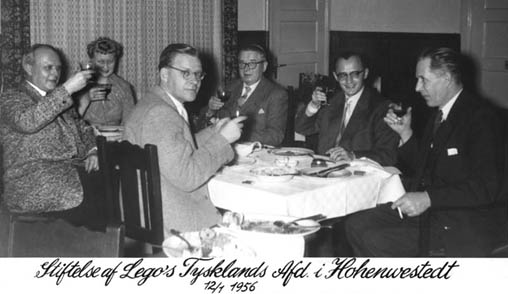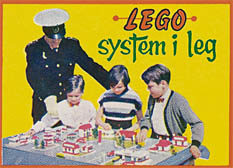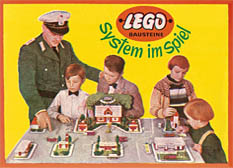Germany
Although the early Scandanivian licenses were successful, Godtfred had plans for Germany, Denmark’s southern neighbor, and, with a population of 50 million, the largest market in Western Europe.
Prior to the War, Germany was the largest manufacturer and exporter of toys in the world, but as early as 1939 the toy industry began to be integrated into the Nazi war effort and toy production was banned altogether in 1943. Like the rest of Europe, the German economy was completely devastated after the War, but the Marshall Plan as well as the currency reform of 1948 resulted in the Wirtschaftswunder (economic miracle) and by the mid 1950’s Germany was again the dominant economy in Europe. Of course this recovery allowed the companies in the famous toy region around Nürnberg-Fürth, such as Arnold, Bub, Fleischmann, Lehmann, Marklin, Schuco, Steiff, and Trix to reconstitute their pre-war toy business. From 1948 to 1953 German toy exports rose from eight to 100 million DM, and by 1957, Schuco, with over 800 employees, was the largest toy company in Europe.
Obviously Germany would be a difficult market for a company the size of Lego to enter, but Godtfred was determined to try anyway. For the 1955 Christmas season he sold sets to some German shops in Schleswig-Holstein (the northernmost state in Germany) directly from Billund. These limited test sales went relatively well but Godtfred had difficulty finding a partner or setting up a true subsidiary until he again met with Axel Thomsen.
Lego Spielwaren
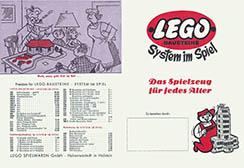
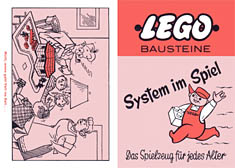
Lego System im Spiel catalog and idea book, 1956
In 1954 Thomsen had moved to Germany and was operating toy factories in both Hohenwestedt and Lerum. In January Godtfred met with Axel in Hohenwestedt after a trip to the Danish consulate in Hamburg and he agreed to help sell the toy in Germany. By Godtfred did not want a distributor like his arrangement with Thomsen in Sweden; he needed someone who could work full-time with Lego and Thomsen did have his own little dollhouse empire to run.
But Thomsen was so excited by Godtfred’s plans for the System of Play that after a visit to Billund he sold his German factory to his son, Harald, and became the General Manager of Lego Spielwaren GmbH, Lego’s first true foreign sales company.1 1. Spielwarenfabrik Harald Thomsen GmBH, in Hohenweststedt, produced Lundby dollhouses and furniture as late as the 1980’s. The headquarters were set up in an old rail hotel in Hohenwestadt (owned by Thomsen) and the company was incorporated on 12 Jan 1956.
As toy analysts predicted, Thomsen initially had difficulty selling the toy, particularly to larger department stores, The first large store to carry Lego was Karstadt, but Spielzeugfachgeschäft Rasch in Hamburg, then the largest toy store in Germany, refused to stock the toy; they wanted no part of the “plastic junk.” So Axel provided small toy shops with elaborate window displays and quickly filmed a black and white commercial, starring himself, and had it shown in a Hamburg cinema. The result was enough demand that Walter Rasch had no choice but to stock the toy.
After a few years of improvements to the product sales began to grow. In 1963 the sales company was renamed LEGO GmbH and in 1999 it was relocated to the Bavarian city of Munich. By the 1960’s Germany was Lego’s largest foreign market and by 1970 sales reached 67 million DM. Today Germany is still Lego’s largest European Market.
Switzerland

The founding of Lego Spielwaren AG, 1956
While Godtfred was negotiating with Axel Thomsen he was approached by John Schneidegger, a Zurich businessman, about marketing the toy in Switzerland. Godtfred met Schneidegger in Frankfurt while on a trip to return Ole from a convalescent holiday. Schneidegger was so impressed with the System of Play that he agreed to be general manager of the Swiss sales company. Lego spielwaren AG, based in Zurich, was opened in 1957. The Swiss parts of the company would play an increasingly important role over the next 50 years.
The Simplified System
As Lego began to expand their sales they also simplified the Mursten range. Since 1954 Lego had sold both the old panel-like windows and doors and the new window system with “wings” that relied on the studs for attachment. In 1956 the old windows were finally dropped. The slotted bricks were now obsolete and Lego replaced them with a new solid wall design, the first change to the brick since 1949. This new, simplified system would be the only toy offered in new foreign markets.
The Local Sets
Initially as Lego entered foreign markets they changed the boxes to the local language. In Denmark the boxes were labeled System i Leg, in Norway and Sweden - System i Lek, and in Germany - System im Spiel. By 1957, however, there were too many different markets for individual packaging and the boxes began to list all of the translations on the side panels:
- Austria: Lego Bausteine - System im Spiel
- Belgium: Lego Bouwstenen - Systeem bij het Spel/Lego Briques - Du Systeme dans le jeu
- Denmark: Lego Mursten - System i leg
- Germany: Lego Bausteine - System im Spiel
- Netherlands: Lego Bouwstenen - Systeem bij het Spel
- Norway: Lego Mursten - System i lek
- Sweden: Lego Mursten - System i lek
- Switzerland: Lego Bausteine - System im Spiel/Lego Briques - Du Systeme dans le jeu
Beginning in 1958 Lego began to use international Lego System boxes that had no language specific text. This practice of single international boxes, and later instruction books, was used for many years.

